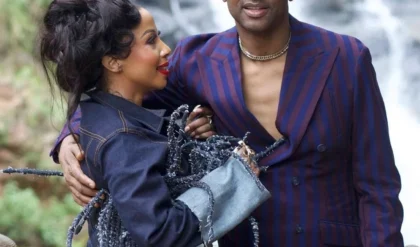Gogo Maweni and Gogo Skhotheni Tension: Ethical Responsibility in the Digital Age
A controversial video allegedly posted on social media by Gogo Maweni, a prominent South African sangoma (traditional healer), has caused a stir.
The video shows a small white coffin placed in a sacred space called Ndumba, accompanied by a chilling message.
In the context of a public spat with Gogo Skhotheni, another sangoma, the video has sparked a major debate about the ethics and significance of traditional spiritual practices.

Personal conflict becomes public focus
The conflict between Gogo Maweni and Gogo Skhotheni is not new. The two spiritualists have repeatedly criticized and accused each other on social media.
However, tensions escalated significantly after Gogo Skhotheni suffered the loss of a child.
Instead of receiving sympathy, the conflict between the two people continued to become the focus of public opinion, making the public uncomfortable when personal pain was pushed into the public space.
Controversial video and public reaction
The white coffin in the video symbolizes death, but placed in the Ndumba space – a place for performing healing rituals and connecting with ancestors – was shocking.
In addition, the message in the video, implying that Gogo Skhotheni’s child “will never return,” further increased the feeling of insecurity and anger.
For many, this action not only violated personal morality but also seriously offended the sacred meaning of Ndumba.

The impact of social media on spiritual practice
The incident shows the strong influence of social media on traditional spiritual practices. Digital platforms, which facilitate the sharing of culture and beliefs, are increasingly becoming places where personal conflicts are amplified and even commercialized.
Rituals that are inherently sacred are now easily manipulated into tools for personal gain, undermining public trust in these practices.
In the case of Gogo Maweni, many have criticized the use of Ndumba as a platform for personal vendettas as unacceptable. Furthermore, making images of death public not only hurts the person suffering, but also devalues traditional spiritual practices.

Lessons from the incident
This incident is a reminder that spiritual leaders need to be aware of their ethical responsibilities when using social media. They are not only transmitters of spiritual knowledge but also representatives of deep cultural values.
The misuse of sacred rituals and symbols not only causes harm to individuals but also erodes the spiritual values of the entire community.
Hopefully, the incident between Gogo Maweni and Gogo Skhotheni will serve as a lesson for spiritual leaders to consider more carefully how they conduct themselves and convey their messages, in order to preserve the sanctity of spiritual practices in the digital age.
News
MaWhoo Speaks Out on Poor Service at Life Fourways Private Hospital
MaWhoo Speaks Out on Poor Service at Life Fourways Private Hospital: Allegations of R@ci@l Bias South African media personality MaWhoo, known for her candid and outspoken nature, has recently made headlines by speaking out about the poor service she received…
Tyla flaunts her jaw-dropping figure in a tiny bralette as she dresses in head-to-toe Nike for the 2025 Super Bowl
Tyla turned up the heat with her racy outfit as she made her way to the 2025 Super Bowl in New Orleans on Sunday. The South African singer, 22, was dressed in head-to-toe Nike as she prepared to watch the Philadelphia Eagles take on the Kansas City…
ShaunMusiq and Thatohatsi Set to Release New Single “Phinde” This Friday
ShaunMusiq and Thatohatsi Set to Release New Single “Phinde” This Friday Exciting news for fans of South African music! The dynamic duo of ShaunMusiq and Thatohatsi is all set to drop their highly anticipated single “Phinde” this Friday. This collaboration…
Remembering Kiernan “AKA” Forbes: A South African Hip-Hop Icon
Remembering AKA: Two Years On Today marks a somber anniversary in the South African music industry as we remember the loss of one of its brightest stars, Kiernan “AKA” Forbes, who tragically passed away two years ago on February 10th….
Big Zulu’s New Helicopter: A Symbol of Success and Inspiration
Big Zulu’s New Helicopter: A Testament to Inspiration and Success South African rapper Big Zulu has once again made headlines, this time for an exciting new milestone in his life. The celebrated artist recently acquired a brand-new helicopter, a symbol…
Lasizwe: Ready to Embrace Fatherhood?
Lasizwe: Ready to Embrace Fatherhood? Lasizwe Dambuza, the popular South African social media personality and television presenter, has been making headlines recently with rumors swirling about his readiness to become a dad. Known for his vibrant personality and entertaining content,…
End of content
No more pages to load











